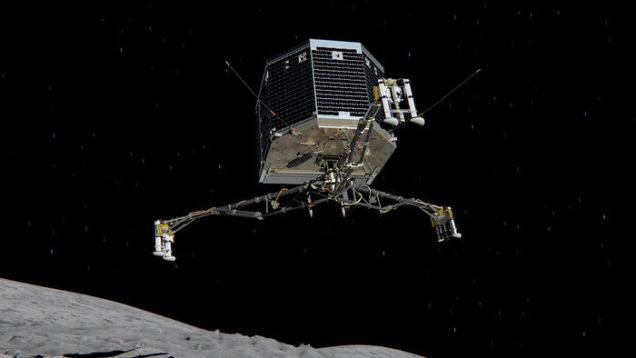Rosetta’s lander is hibernating on a comet now, waiting for a brighter sun. The mission’s scientists, though, have been hard at work, scrutinising reams of data and predicting how the lander could wake up. At the American Geophysical Union (AGU) meeting today, Rosetta’s scientists dropped some intriguing hints of what’s to come.
In case you haven’t been following along with this space drama, the European Space Agency launched the spacecraft Rosetta 10 years ago to intercept a comet. Rosetta rendezvoused with its target earlier this year and dropped a little lander, Philae, onto the ball of ice and rock. But everything did not go as planned, and the lander ended up bouncing twice before coming to rest under a shadowy cliff. Without enough sun for its solar powers, it went into hibernation early. Rosetta, the spacecraft, is still orbiting the comet taking measurements.
Here’s everything we’ve learned about Rosetta today, and what’s still to come.
Where exactly did Philae land?
Well, we still don’t know exactly, but the data that will very likely tell us has just made its 480 million kilometre journey back to Earth. Holger Sierks, the scientist responsible for the camera on Rosetta that is looking for Philae, said in a press conference today that they carried out three search campaigns on December 12, 13 and 14. These search campaigns will likely have photographed the lander in the sun, whereas the lander was probably in the shadow in two previous (unsuccessful) searches. Now, it’s just a matter of painstakingly sifting through the photos.
Where did Philae’s landing go wrong?
One reason that Philae may have bounced so high (two miles!) is that the comet had an unexpected ice-dust crust from through a process called sintering. Basically, it’s when grains fuse together to form an especially hard surface that prevented Philae from landing smoothly.
Will Philae ever wake up?
Jean-Pierre Bibring, the lead lander scientist, expressed confidence that Philae will come out of hibernation as the comet approaches the sun, possibly in February or March of next year. For that to be successful, though, two things need to happen.
One, its solar panels need to get enough sun. Right now, we of course still don’t know exactly where the lander is, so it’s hard to predict how much sun it will get. Second, the Philae needs to survive the brutally cold conditions of the comet. It’s hard to measure the temperature inside the lander, but Bibring says, “survival is warranted.”
What organic molecules has Rosetta found?
A while back, it was announced that Rosetta instruments had detected organic molecules on the comet. But are those molecules simple ones like methane or complex ones that could provide evidence for comets seeding life on Earth? Bibring confirmed they have found large organic molecules of masses up to 100 (in comparison, methane’s is 16), but they’re still working to precisely identify what they are. We’ll just have to wait and see.
Researchers will be presenting more of their Rosetta results in greater scientific detail at the AGU meeting this afternoon — I’ll update with more information as I learn more.
